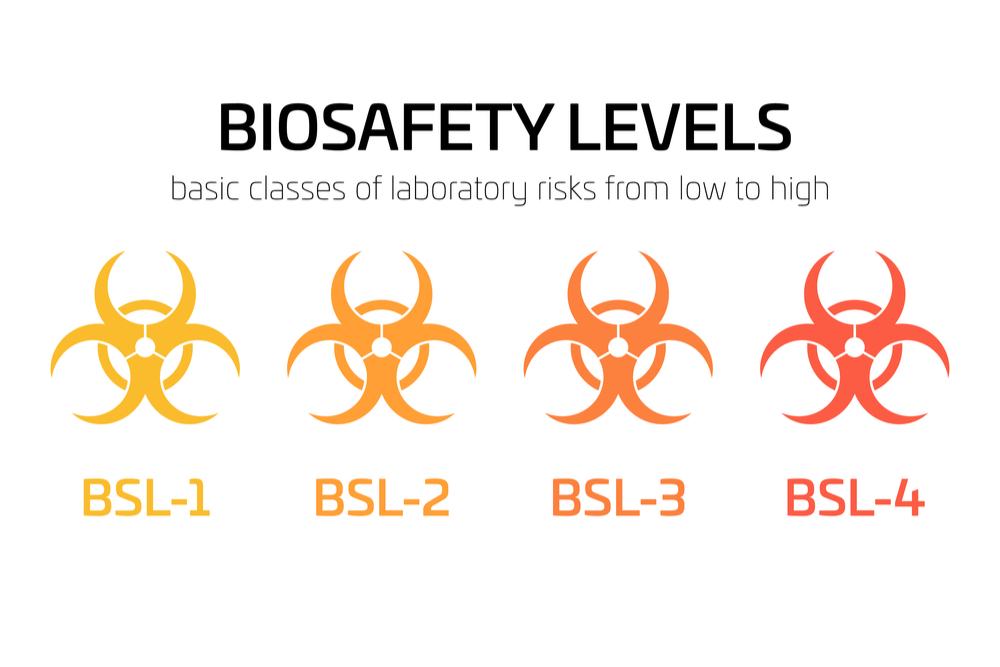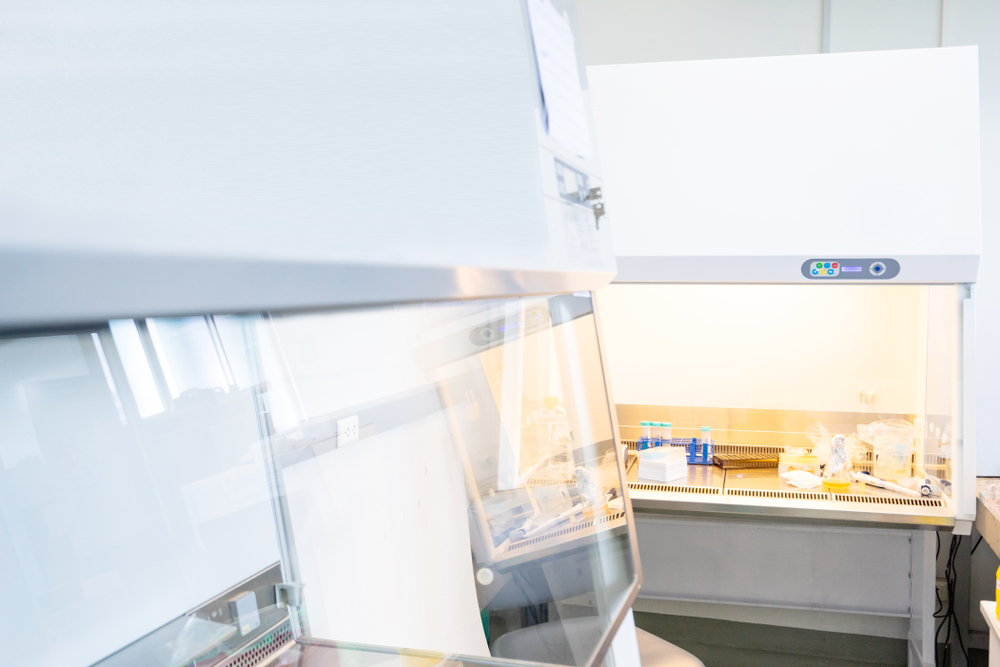In biological labs, all personnel must take precautions in order to protect themselves, their co-workers and their environment. Similar to the testing and certification of lab equipment, lab facilities must meet certain standards. These standards ensure the safe handling of dangerous organisms.
As a lab equipment certification company based in New York, we are well versed in Biosafety Levels (BSLs). Below, we describe what BSLs are, what is the difference, and who establishes the ratings.
Original publish date: December 20, 2020 | Updated on: February 13, 2024
What are Biosafety Levels?
Essentially, biosafety levels are containment precautions. They’re a mandatory requirement in any biological research facility. Biosafety levels contribute to the isolation of dangerous organisms and lethal agents. Furthermore, your biosafety lab’s equipment and spaces need regular maintenance, testing and certification in order to maintain safe conditions.
There are four different biosafety classifications, 1-4. Additionally, we’ve broken them down below to provide some further information on their distinctions.
Biosafety levels (BSL) range from 1 to 4, with each level representing an increasing level of containment and safety measures. Here’s a brief overview of the differences between BSL 1 through 4:
- BSL-1 (Basic Level):
- Agents: Generally non-pathogenic and not known to cause disease in healthy humans.
- Containment: Standard laboratory practices, such as good hygiene and basic protective equipment (lab coats, gloves, and eye protection).
- BSL-2 (Moderate Level):
- Agents: Associated with human diseases, but vaccines or treatments are often available.
- Containment: BSL-1 measures plus restricted access, biohazard warning signs, and additional protective equipment. Work is typically performed in a biological safety cabinet.
- BSL-3 (High Level):
- Agents: Indigenous or exotic agents that may cause serious or potentially lethal diseases through inhalation.
- Containment: BSL-2 measures plus controlled access, decontamination of waste, and additional facility design requirements. Work is typically performed in dedicated biosafety cabinets or in a separate building.
- BSL-4 (Maximum Level):
- Agents: Dangerous and exotic agents that pose a high risk of aerosol-transmitted infections, often with no available vaccines or treatments.
- Containment: BSL-3 measures plus complete personnel decontamination, sealed and negative pressure environments, and stringent facility design requirements. Work is conducted in a separate, highly secure facility with multiple layers of containment.
In summary, the primary differences between the biosafety levels lie in the types of agents being handled, the containment measures in place, and the level of protective equipment and facility design required. As the biosafety level increases, there is a corresponding increase in the stringency of safety measures to prevent accidental exposure and release of potentially harmful agents.

Biosafety Level 1 (BSL-1)
At the lowest level of the biosafety classification, level 1 is basically the least dangerous. Lab personnel are handling specimens with little risk of infecting healthy human beings. One example of a microbe with a level 1 rating (BSL-1) is E. coli.
While handling BSL-1 specimens, the lab doesn’t need any advanced containment equipment. Nor does a BSL-1 lab need to be isolated from any of its neighboring facilities.
Safety precautions taken by personnel are standard for any scientific facility. For example, employees must wash their hands, wear personal protective equipment (PPE), sterilize surfaces and keep food/drink out of the lab.
Biosafety Level 2 (BSL-2)
Biosafety level 2 (BSL-2) describes laboratories that work with pathogenic or infectious organisms that pose a moderate health hazard. Some examples of BSL-2 agents are the HIV virus and Staphylococcus aureus (staph infections).
Laboratories with a BSL-2 classification have similar precautions as those with a BSL-1 rating. However, there are a few enhanced policies in place. Personnel working within a BSL-2 facility must proceed with more caution. They also must take enormous care in preventing any cuts or abrasions of the skin.
In a BSL-2 lab, personal protective equipment is mandatory, including lab coats and gloves. When necessary, workers must wear face shields and eye protection. Any procedures or tests that can lead to a harmful splash or chemical spill must be performed within a biosafety cabinet (BSC).
A biosafety cabinet (BSC) is an enclosed and ventilated space within the lab. Any technicians working with dangerous pathogens must do so within the BSC. When handling organisms with a rating of BSL-2 and up, a BSC is critical. At S.E.P.S., we provide biosafety cabinet testing and certification to ensure they meet NSF-49 guidelines and manufacturer specifications.
An autoclave (a pressure chamber that sterilizes equipment and instruments) provides exceptional decontamination. Also, there are sinks and eyewash stations throughout.
Personnel access into a BSL-2 lab is more restrictive than BSL-1. Anyone without proper authorization may not enter the lab, especially while researchers conduct work.
Biosafety Level 3 (BSL-3)
Laboratories that operate with a BSL-3 classification often handle organisms that can be fatal if inhaled. Some BSL-3 microbes include yellow fever, West Nile virus, and tuberculosis-causing bacteria.
These organisms are threatening enough that any facility handling them must register their work with government agencies. Anyone working in the lab must remain under medical surveillance. They also must receive immunization for the microbes they’re handling.
Uniform airflow directs clean air into the lab. Additionally, these labs use fume hoods to direct harmful vapors out. Your fume hoods will require regular testing and certification to ensure they’re operating safely and effectively.
Additionally, requirements for a BSL-3 facility include protective equipment, respirators, coveralls and wrap-around gowns. All work must be performed within a biosafety cabinet (BSC).
HEPA filtration is required for all BSL-3 labs, and S.E.P.S. technicians can test the integrity of your system.
Biosafety Level 4 (BSL-4)
Biosafety level 4 (BSL-4) labs are uncommon. While they’re rare, that doesn’t mean they don’t exist. BSL-4 is the very highest level of biological safety a facility can attain, and consequently, they handle the most exotic and deadly microbes.
Infections caused by microbes found within a BSL-4 facility are, more often than not, fatal. The most unsettling part is that there are no vaccinations or treatments for them. Two known examples of BSL-4 organisms are Ebola and Marburg viruses.
Any personnel operating within a BSL-4 facility are required to change clothing upon entering and shower immediately upon exiting. All materials must be decontaminated before staff leaves the facility. The staff must wear all the personal protective equipment described in the previous BSL safety ratings, as well as full-body, air-supplied suits. All work performed must be done within a Class III biosafety cabinet (BSC).
BSL-4 laboratories must be kept isolated and totally separate from neighboring facilities. They also feature intricate exhaust and ventilation systems, designed to constantly ensure the flow of clean air.
Who Establishes Biosafety Levels?
National and international organizations establish the biosafety levels. They do this using guidelines developed by government agencies responsible for public health and laboratory safety. In the United States, the Centers for Disease Control and Prevention (CDC) plays a significant role in defining and recommending biosafety levels. The CDC’s publication “Biosafety in Microbiological and Biomedical Laboratories” (BMBL) is a widely used reference that provides guidelines for establishing and maintaining different biosafety levels.
Internationally, the World Health Organization (WHO) also contributes to biosafety guidelines and standards. Additionally, other countries have their own regulatory bodies or public health agencies that establish biosafety regulations based on international guidelines and their specific national needs.
It’s important to note that while the CDC and WHO provide recommendations and guidelines, the actual implementation and enforcement of biosafety regulations may vary from country to country.
Overseen by regulatory agencies and the scientific community, compliance ensures the safe handling of infectious agents in laboratory settings.
Conclusion
Working within a lab setting, particularly in biological sciences, can be hazardous. Knowing and understanding biosafety levels is imperative to ensuring every worker remains safe. Nowadays, in the age of COVID-19, lab safety has never been so important.
In any research environment, decontamination is of the highest priority. At SEPS, we can provide you with scheduled testing and certification to guarantee your lab is operating with the highest of quality standards.
About SEPS Services
At SEPS, we have over 18 years of experience providing services for various scientific facilities. Biosafety cabinet maintenance, certifications, scientific equipment decontamination and fume hood testing and certification are just a few of the services we offer. When it comes to the field of controlled environments, nothing but the very highest standards suffice. SEPS has the experience and expertise to collaborate in all scientific industries, including pharmaceutical and biological.
